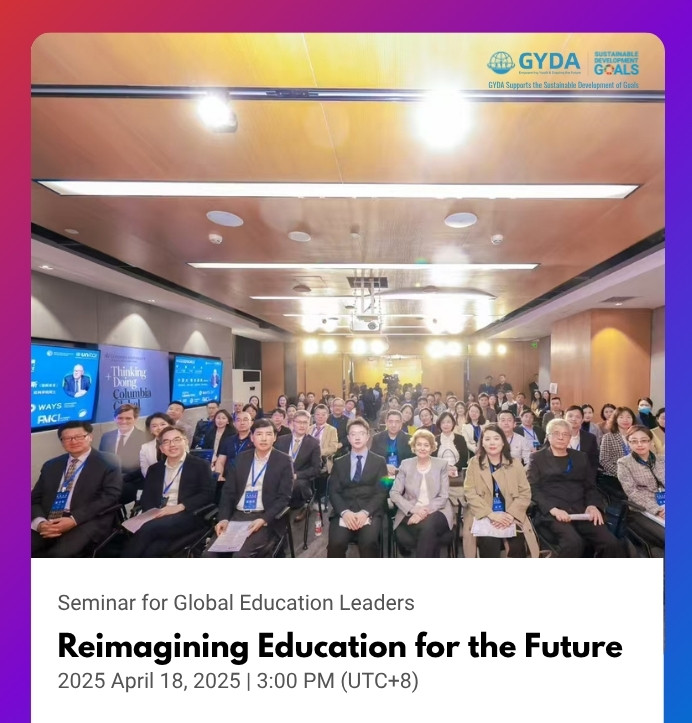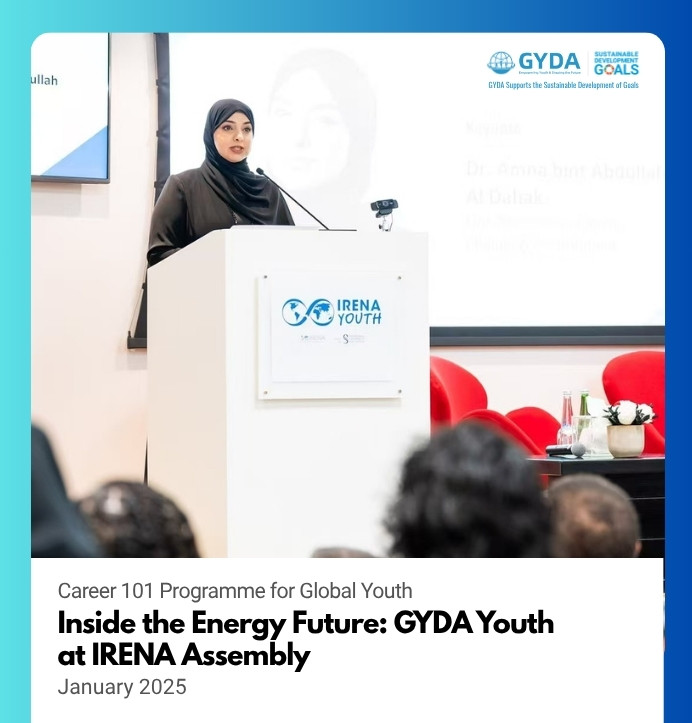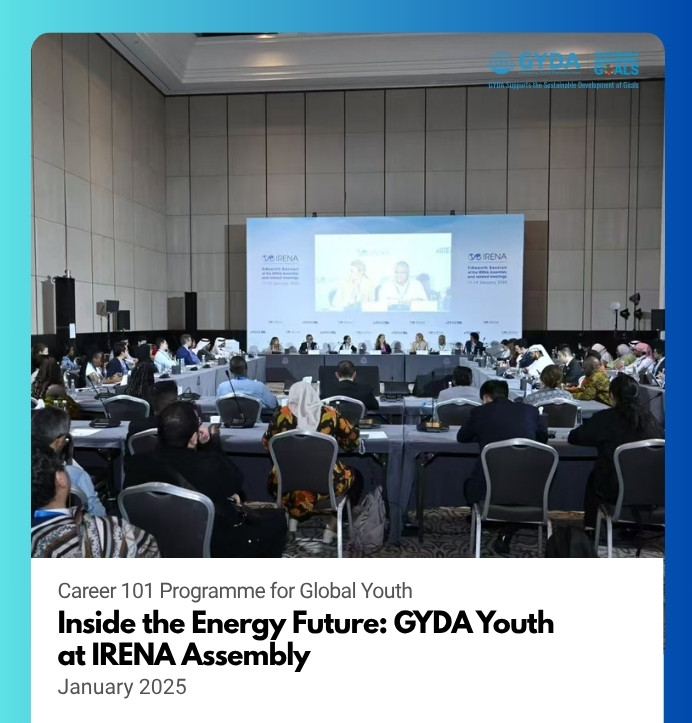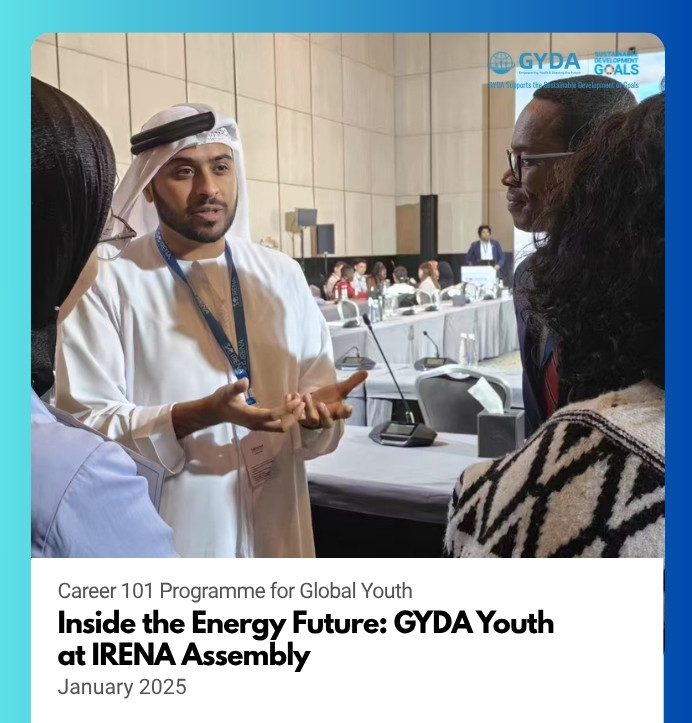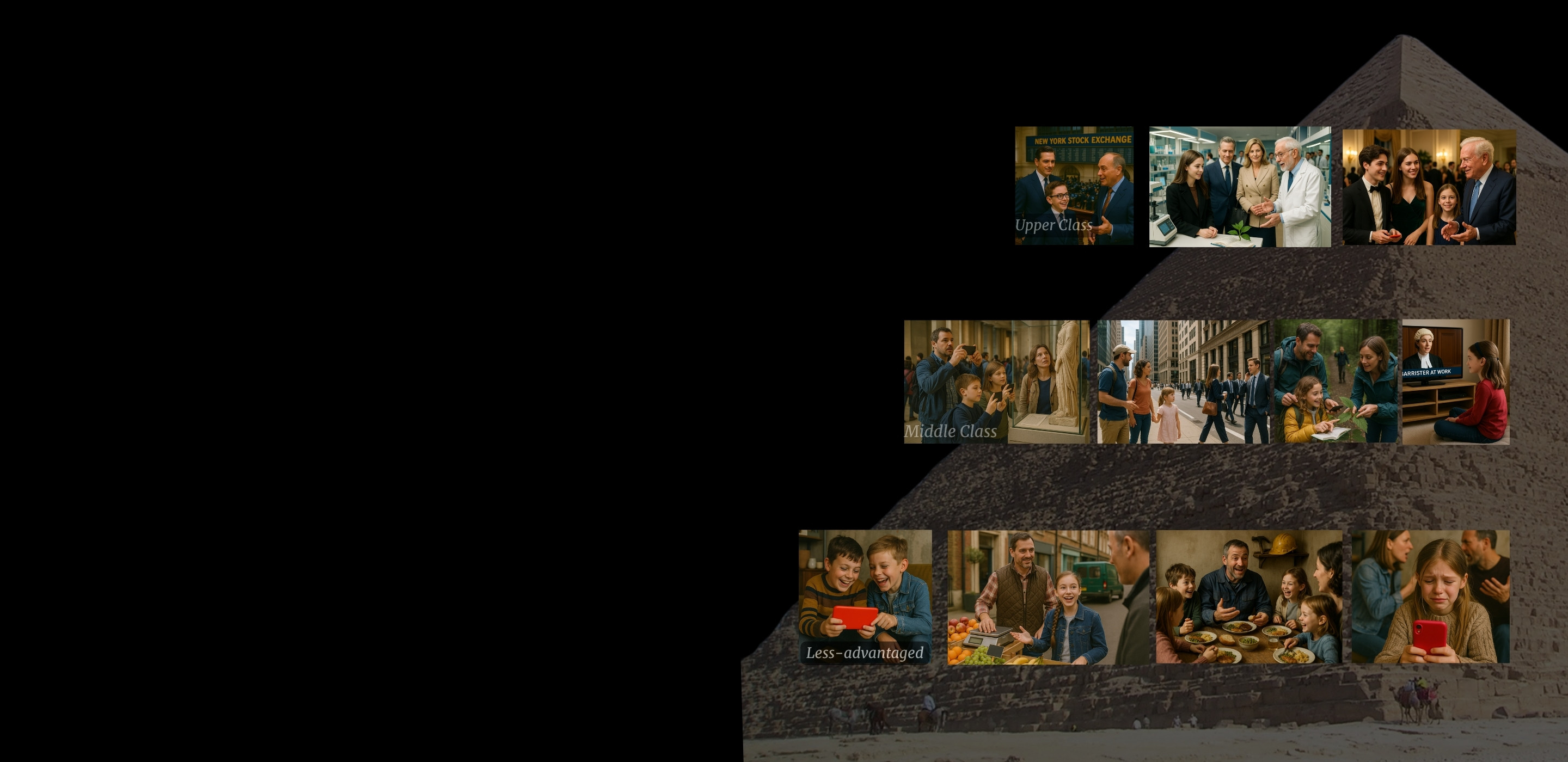
.
Dream MakerWhat a Child Sees Shapes What They Believe Is Possible
Upper-class children grow up with professional role models and rich exposure; others often lack such access, limiting their imagination.
✦ Dream Maker ✦ aims at making opportunities for early exposure and aspiration available to all, not just those at the top.
Ensuring the right to be inspired isn’t a privilege, but a system.
Bridging the gap between knowledge hubs and underserved communities.
Making complex ideas visible and relatable for all children.
The Hidden and Cruel Fact
True inspiration comes from seeing, feeling, and understanding something so vividly that it sparks a new desire to learn, to dream, and to become.
How Children Encounter the Stock Market

A child from an ordinary background may only encounter the concept of the stock market in a school textbook—described in abstract terms and filled with unfamiliar jargon.
Without further explaination or connect it to real life, it remains distant and unrelatable.
It sounds complicated. I don’t really get it.
The idea fades quickly, leaving no impression or desire to explore further.

A child from a middle-income family might hear about stocks when their parents complain about losing money on an investment.
The idea enters the household, but it’s wrapped in anxiety and caution, not clarity.
Investing is risky. It’s for people who can afford to lose.
The child grows curious—but with doubt, and without guidance or understanding.

In 1940, At just 10 years old, Warren Buffett was taken to the New York Stock Exchange by his father—a Congressman and stockbroker. He stood on the trading floor and even met the head of Goldman Sachs.
I was fascinated by what I saw... It was a life-shaping moment.
— Warren Buffett, recalling his visit to the NYSE
The experience planted a seed of fascination that grew into lifelong purpose and mastery.
How Children Encounter Cultural Relics

A child from a modest background hears the name “Houmuwu Ding” in a history class.
Mentioned briefly alongside other ancient artifacts, with no deeper context or imagery.
It’s just one of those ancient things, right? Like from a test?
The encounter is passive—there is no emotional resonance, no connection to time, place, or identity.
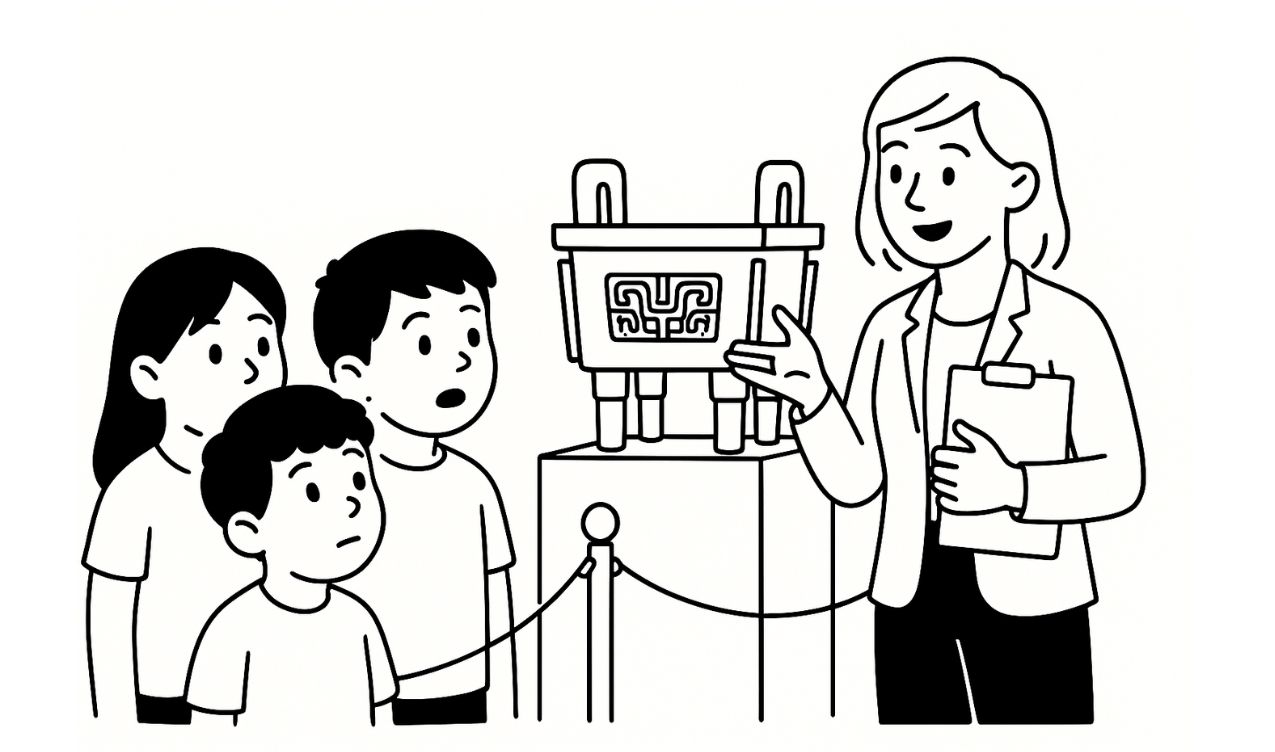
Visiting a museum, the child sees the Houmuwu Ding—or a replica—up close.
A guide explains that it was a massive bronze vessel used in Shang dynasty rituals, dedicated to an ancestral queen.
Wow... they cast this more than 3,000 years ago?
Curiosity is sparked—but without guidance beyond the display, the meaning fades into novelty.

Speaks directly with a lead archaeologist in private study room.
The conversation doesn’t stop at metallurgy or dynastic rituals. It opens into how historical authority is built: who gets to authenticate the past, whose voices are cited, which stories enter textbooks, and who funds the narratives that shape public memory.
Knowledge isn’t just what’s written—it’s who gets to shape the story, and who knows where to look.
The child doesn’t just learn about history—they begin to see the underlying networks of culture, power, and opportunity that define how knowledge is made and used.
"Cultural Capital" Shapes the New Privileged Class
Many empirical research suggests that such insider knowledge plays a critical role in shaping one’s awareness of opportunity and ability to act on it—long before formal choices like university majors or job applications are made.
Below are key statistics that illustrate how cultural capital quietly influences lifelong outcomes:
If a parent is a politician[1]
If a parent is in medicine[2]
If a parent is in law[2]
Are children of professionals or managers[2]
Came from upper-middle/upper-class families[3]
Have upper-class family backgrounds[3]
[2] Laurison, D. & Friedman, S. “The Class Pay Gap in Higher Professional Occupations.” American Sociological Review, 2016.
[3] Zweigenhaft, R. L., & Domhoff, G. W. The New CEOs. Rowman & Littlefield, 2011.
Although the internet and AI have significantly expanded access to general information, they do not necessarily open the door to insider knowledge, such as the personal insights, experiences, nuanced interpretations, and unwritten norms shared by leading figures. This form of knowledge is typically transmitted informally, through direct conversations and long-term exposure within elite networks.
Young individuals embedded in such elite networks are more likely to encounter thought-provoking discussions, contextualized advice, and timely mentorship, which can catalyze early goal formation by helping them develop interests, aspirations, and direction at an early stage.
GYDA Facilitates Equal Access
Not only through programs for young individuals, but also by advancing the "education of educators"—we organize high-level workshops for leaders in education.
Seminar for Global Education Leaders
Empowering Those Who Inspire
.
We bring together school leaders, policymakers, and distinguished voices from academia and industry to foster thoughtful exchange and drive educational vision forward.
- Hosted on-site worldwide
- Joined by leaders from UNESCO, UNITAR, etc.
- Structured as a recurring, platform-based seminar series
- Focused on actionable topics shaping the future of education
<
div
class
=
"
swiper-container swiper"
id
=
"
swiper-1"
data-pagination-type
=
"
"
data-speed
=
"
400"
data-space-between
=
"
100"
data-pagination
=
"
true"
data-navigation
=
"
false"
data-autoplay
=
"
true"
data-autoplay-delay
=
"
3000"
data-breakpoints
=
'
{"480": {"slidesPerView": 1}, "768": {"slidesPerView": 1}, "1024": {"slidesPerView": 1}}'
>
<
div
class
=
"
swiper-wrapper pb-6 mx-auto"
>
<
div
class
=
"
swiper-slide"
>
<
img
src
=
"
../assets/images/service/project-small-img-1.jpg"
alt
=
"
project"
class
=
"
img-fluid rounded-3"
/>
</
div
>
<
div
class
=
"
swiper-slide"
>
<
img
src
=
"
../assets/images/service/project-small-img-2.jpg"
alt
=
"
project"
class
=
"
img-fluid rounded-3"
/>
</
div
>
<
div
class
=
"
swiper-slide"
>
<
img
src
=
"
../assets/images/service/project-small-img-3.jpg"
alt
=
"
project"
class
=
"
img-fluid rounded-3"
/>
</
div
>
<!-- Add more slides as needed -->
</
div
>
<!-- Add Pagination -->
<
div
class
=
"
swiper-pagination"
>
</
div
>
<!-- Add Navigation -->
<
div
class
=
"
swiper-navigation"
>
<
div
class
=
"
swiper-button-next"
>
</
div
>
<
div
class
=
"
swiper-button-prev"
>
</
div
>
</
div
>
</
div
>
Career 101 Programme for Global Youth
Early Exposure, Informed Choices
.
We help young individuals understand the essence, potential, and access routes of various careers—long before formal choices like college majors are made.
- Covers both broad career exploration and deep dives into specific fields
- Follows a natural curve: industry teasers → core knowledge → real-scenario labs → step-by-step personal guidance
- First module unlocked: collaboration with IRENA, simulating work inside an international energy agency
<
div
class
=
"
swiper-container swiper"
id
=
"
swiper-1"
data-pagination-type
=
"
"
data-speed
=
"
400"
data-space-between
=
"
100"
data-pagination
=
"
true"
data-navigation
=
"
false"
data-autoplay
=
"
true"
data-autoplay-delay
=
"
3000"
data-breakpoints
=
'
{"480": {"slidesPerView": 1}, "768": {"slidesPerView": 1}, "1024": {"slidesPerView": 1}}'
>
<
div
class
=
"
swiper-wrapper pb-6 mx-auto"
>
<
div
class
=
"
swiper-slide"
>
<
img
src
=
"
../assets/images/service/project-small-img-1.jpg"
alt
=
"
project"
class
=
"
img-fluid rounded-3"
/>
</
div
>
<
div
class
=
"
swiper-slide"
>
<
img
src
=
"
../assets/images/service/project-small-img-2.jpg"
alt
=
"
project"
class
=
"
img-fluid rounded-3"
/>
</
div
>
<
div
class
=
"
swiper-slide"
>
<
img
src
=
"
../assets/images/service/project-small-img-3.jpg"
alt
=
"
project"
class
=
"
img-fluid rounded-3"
/>
</
div
>
<!-- Add more slides as needed -->
</
div
>
<!-- Add Pagination -->
<
div
class
=
"
swiper-pagination"
>
</
div
>
<!-- Add Navigation -->
<
div
class
=
"
swiper-navigation"
>
<
div
class
=
"
swiper-button-next"
>
</
div
>
<
div
class
=
"
swiper-button-prev"
>
</
div
>
</
div
>
</
div
>

